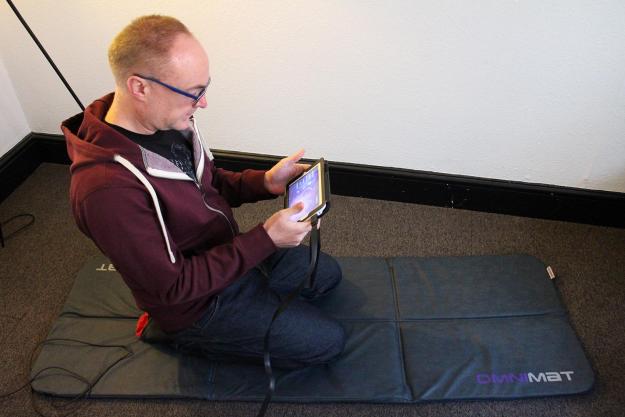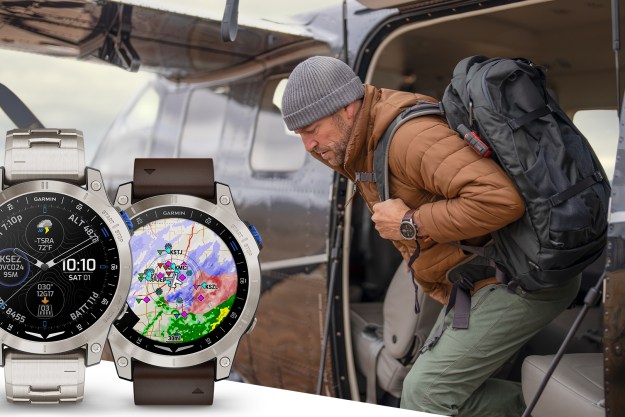
“It looks like a high-tech yoga mat, and the potential health benefits from its NASA-derived tech are to intriguing to dismiss. However, finding those benefits is a long process, and even then, it's hard to isolate whether it's doing any good.”
- Promised benefits are intriguing
- Complete all-in-one portability
- Fascinating technology
- Comes with its own Android tablet
- It’s very expensive
- The benefits vary
- Requires dedication and commitment
Fox Mulder had a poster of a UFO on his basement office wall with the words “I Want To Believe” under it. That’s me, too. For the last eight weeks, I’ve had the EMPpad on the floor of my bedroom, and everyday I’d look at it and hear the words on that poster — I want to believe.
There’s a good chance you’ve never heard of the EMPpad. It’s a space-age piece of health and fitness tech that has its roots in research by Nikola Tesla, and subsequently NASA. The device promises a wide range of very enticing benefits in its use, ranging from anti-aging, better sleep, less stress, and faster recovery from injuries. All this could come from spending 20 minutes a day laying on what looks like a yoga mat plugged into an Android tablet.
The EMPpad uses pulsed electromagnetic fields (PEMF) to work its magic. Their use is well documented in medical research, and NASA uses them to help astronauts reverse bone loss after extended stays in space. At the same time, the astronauts saw other benefits from PEMF treatment. Athletes find it helps tissue and ligaments heal quicker, and people note pain relief from chronic conditions like arthritis. Again, this isn’t about a special exercise, a nutritional drink, membership of a cult, or a magnetic wristband. It’s from laying down on a squashy mat.
The PEMF waves are delivered through the OmniMat, which looks like a regular yoga mat. It has six copper coils hidden inside, and you lay or sit down on it. The mat plugs into the Omnium1, a custom-made 8-inch Android tablet with a gigantic battery to power the whole setup. The tablet controls the mode — there’s a different one depending on the time of day — the intensity of the waves, and the duration. It doesn’t need external power, so the whole kit can be used anywhere, and at any time.
The EMPpad’s benefits sounds like fantasy, and the method it uses is like one of those magic belts that supposedly give you rock-hard abs without any effort. However, there’s real science behind it, and it’s made by passionate and genuinely inspiring people. Could this crossover of futuristic medical and consumer tech really deliver?
Specially created program, tailored to individual needs
I was initially given a guided tour of the EMPpad by its creators, and had a special treatment plan made for me, primarily focused on improving general wellbeing, and treating a recurring back injury. It was rather surreal — laying back on the OmniMat in a London office, while being observed by two men in white coats telling me about the electromagnetic waves pulsing through my body. I was, for a moment, slightly concerned for my safety. Would I explode in a Scanners-style attack, or be zapped into a Videodrome-style waking nightmare?
Neither happened, obviously, and I left feeling excited about trying such an unusual and genuinely exciting piece of technology. I was at the start of an eight-week experiment. How would it end up changing my life, if at all?
This was my routine. Eight minutes in the morning, at a high intensity. Then, 12 minutes just before bed on the lowest setting. The pre-bed session is supposed to relax your body and give you a better night’s sleep. I already sleep pretty well, so I never noticed much difference here. I used the EMPpad diligently for six weeks, and was told I should notice the benefits after around two.
Recognizing all the benefits is a challenge
I took a very unflattering selfie when I began using the EMPpad — and again after about seven weeks. There was a definite difference in my skin tone, my face looked healthier, and the EMPpad was the only new thing I was doing. It’s important to note that I try to maintain an almost Patrick Bateman-style skincare regime, and speaking to Omnium’s Steve Harper, I was told the EMPpad operates at its best when you’re treating your body well in the first place, from regular exercise to taking vitamins each day.
Benefits could come from spending 20 minutes a day laying on a yoga mat plugged into an Android tablet.
There was further evidence of this later on, when my ancient office chair finally gave up, and began slowly but surely crippling me. Steve tweaked my EMPpad program to help out, and I purchased a new chair. In a couple of days, my back and neck pain had subsided — a recovery that in the past, thanks to the injury, would have taken about a week. The combination of a supportive chair and the EMPpad’s soothing waves appeared to speed everything up.
I never actually felt anything while using the EMPpad. No tingles, heat, or anything else unusual. In fact, it’s one of those devices where you wonder if it’s really doing anything at all. Was it all in my mind? Well, the EMPpad wasn’t always successful. There was a chance it would help me recover from jet lag faster than usual, but I didn’t notice any difference returning to the UK from Las Vegas, it didn’t improve my sleep, and I felt no change in my general wellbeing. However, I’ve not used the EMPpad for two weeks now, and there are some annoying blemishes on my face that refuse to disappear. I’m fairly sure regularly laying down on the pad would banish them.
It’s difficult to establish whether the EMPpad makes any difference, which leads on to integrating it into one’s lifestyle. Steve says it’s like brushing your teeth — once you get in the habit, you wouldn’t stop. This is true, but it’s still hard to keep up the motivation for doing it every day, on a long-term basis, due to the nature of any benefits. They’re not immediately obvious, and are subtle enough that they creep in without you really noticing. If you’re the sort of person who religiously goes to the gym, or has no problem sticking to a strict schedule, then the EMPpad could probably easily fit into your life. If you’re all over the place, and expect instant, obvious results, then it may be a tougher ask.
A price as astronomical as its NASA origins
Then, we come to the price. For me, the EMPpad seemed to make a difference. How much of a difference isn’t clear, but it definitely did something. I’d still be using it everyday, as even the few minutes spent on it was relaxation time I rarely factor in to my days. Except now the EMPpad has gone back, it’s highly unlikely I’ll use one ever again, because it costs £2,600 (about $4,000 U.S. dollars) to buy. That’s more than my last car cost, and at that price, I’ll live with less than perfect skin and the week it takes my back to feel better when it acts up.
Why is it so expensive? Interestingly, it comes down to the tablet that is used to control the EMPpad. The Omnium1 has been designed from the ground up by the team, and is the brains behind the EMPpad itself. The circuit board, complex power management, and D/A converter are all unique to the Omnium1, and the tablet is made in the thousands, rather than the millions. This, combined with the medical grade technology and software, means it doesn’t come cheap.
The tablet does its job well. It powers the mat, runs the app, and can be used to watch video or browse the Internet while the program is running. However, try to stack the specs up against high-end equipment sold by Apple, Samsung, and Microsoft, and it’s not going to win many battles. Because it has a gigantic 9,000mAh battery inside, it’s a weighty piece of equipment, but it’s not ungainly thanks to the compact 8-inch screen. The 1,280 x 800 pixel resolution is acceptable — just — and there’s a quad-core Rockchip processor with 1GB of RAM powering the Android 4.4 KitKat OS.
However, give the Omnium1 tablet another six months to a year, and technically it’s going to be woefully out of date. Due to it being an integral part of the EMPpad’s operation, owners won’t be able to pop out and buy a new one either. That makes it a very expensive control system for the mat, on which owners may only end up running a single app, and using a more capable device for everything else.
The whole EMPpad experience is controlled using an app. While it can be customized personally — from which pad is being used to duration and intensity of the magnetic pulse — it’ll probably be set up for you. Still, it was simple to use when I tweaked the original program halfway through my test. Using the Omnium1 on a daily basis, as per the program, the battery lasted about five days before needing a recharge, a process that took many hours. I found leaving it on overnight was most effective.
I wanted to believe, but I’m not convinced
The EMPpad and Omnium1 package isn’t a fitness band or a set of Wi-Fi connected scales. It’s a complicated scientifically sound piece of equipment, and the first of its kind. However, because of the price, at the moment it’s a plaything for the rich. Its amorphous benefits rather suit the often over-the-top, health-conscious lifestyles we see media personalities sometimes promoting.
You’ll need patience, dedication, and a packed wallet to see whether the EMPpad can enhance your life. It’s rather sad, because the system is far more interesting and potentially beneficial than some ridiculous diet pushed by a clueless celeb. For me, I wanted to believe in the EMPpad, but I’m still not absolutely convinced it’s benefits are any more real than Mulder’s UFO.
Highs
- Promised benefits are intriguing
- Complete all-in-one portability
- Fascinating technology
- Comes with its own Android tablet
Lows
- It’s very expensive
- The benefits vary
- Requires dedication and commitment
Editors' Recommendations
- Think twice before updating your Samsung phone to One UI 5.1
- Qualcomm’s Snapdragon 6 and 4 Gen 1 chips are big deals for cheap phones
- Nothing’s next phone may ignore the one thing that makes the Phone 1 special
- Nothing Phone 1: Everything we know about Carl Pei’s new phone
- The Nothing Phone 1 won’t be coming to the U.S. after all












